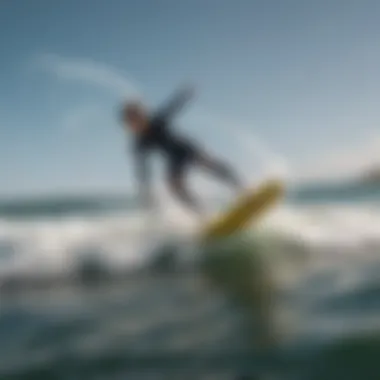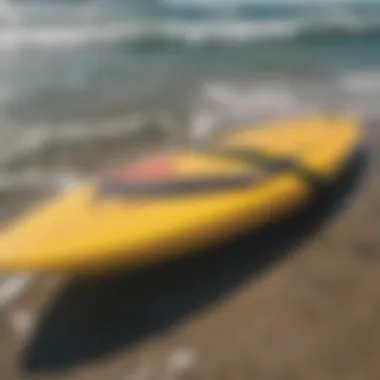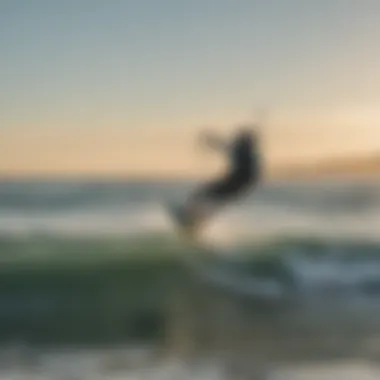The Naish Surfer: Performance and Innovation in Kitesurfing


Intro
In the realm of kitesurfing, Naish surfboards stand out as icons of performance and innovation. This article will take a comprehensive look into what makes Naish a respected name in the kiteboarding community. From technological advancements to design specificity, we will dissect key elements that give Naish its formidable reputation. This introspection will cater to both seasoned riders, who benefit from in-depth knowledge, and newcomers entering the exciting world of kitesurfing.
We're going to explore a multitude of aspects pertinent to Naish products, analyzing performance attributes, material choices, and user preferences. Also, we will consider the overarching impact of the brand on the sport itself and examine the community it cultivates.
Equipment Reviews
Kites
Naish delivers a wide selection of kite models designed to suit varied riders' preferences. Models such as the Naish Pivot and Naish Slash have become favorites among enthusiasts. The features [
Prolusion to Naish Surfboards
Naish surfboards have carved a unique niche within the watersports community. Their significance extends beyond simple clay, becoming a benchmark for performance and innovation in kitesurfing. This section will clarify why an understanding of Naish surfboards is vital for both enthusiasts and newcomers alike.
History of Naish
Established in the early 1970s by Robby Naish, this brand emerged from a passion for windsurfing. Robby Naish himself was a young prodigy, soon to compete at the highest levels of the sport. The brand's initial focus lay in windsurfing equipment, but as the watersports landscape evolved, Naish expanded into kitesurfing and kiteboarding. This evolution signifies more than merely extending product lines; it reflects Naish's ability to adapt and innovate. Over decades, Naish surfboards have become synonymous with high-quality performance, thanks to ongoing research and feedback from users.
In this context, it is crucial to recognize Naish’s pivotal role in shaping modern kitesurf equipment. Each Naish board represents a melding of experience, professional input, and technological advancement. What began as a quest for superior gear is now a rich legacy of performance-oriented designs.
Naish's Role in Watersports Innovation
Naish consistently stays at the forefront of innovation in the kitesurfing industry. Their efforts include not only refining board shape and design but also examining broader aspects such as rider experience and user adaptability. They strive to push the boundaries of performance by integrating advanced materials and construction techniques. This commitment enables their products to cater to a diverse audience, from beginner users to seasoned professionals.
A representation of Naish's dedication to innovation is their extensive research on fin designs, rocker profiles, and tail shapes. They assess how these elements interact to facilitate better performance and control. Moreover, Naish gathers insights from the global riding community. By adopting an inclusive design approach that incorporates feedback and continual testing, Naish cultivates products built for precision.
“Innovating the experience, Naish not only shapes boards but also perceptions within kitesurfing.”
In summary, a comprehensive overview of Naish surfboards highlights the importance of history and innovation in the sport. Seasoned riders and novices alike benefit from understanding these aspects as they evaluate equipment choices. With a strong legacy and a forward momentum, Naish lays a path consequential for the entire outriding community.
--
Understanding Surfboard Design
Understanding surfboard design is critical for any kitesurfer looking to enhance their skill and enjoy the water. A surfboard is not just a piece of foam and fiberglass; it is carefully engineered to create a specific user experience. Features like shape, size, and materials contribute to the overall performance of the board. Accurate comprehension of surfboard design can lead to better performance across various conditions. This knowledge enables riders to select equipment that suits their style, giving them a more tailored riding experience.
As this article unfolds, you will see that a solid understanding of these design principles helps both beginners and professionals alike make informed decisions.
Key Elements of Surfboard Design
When analyzing surfboard design, several key elements stand out. Firstly, shape significantly impact performance. The outline and contours of a board dictate its handling and speed. There are various shapes like fish, shortboards, and longboards, each designed for specific surfing conditions.
Another vital factor is volume. This relates to buoyancy, which plays a large role in support and stability on the water. Riders should select boards with appropriate volume for their weight and experience level, which makes a major difference in the ability to ride effectively.
Fin configuration also deserves special mention. The type and number of fins can influence control, turn radius, and acceleration. In addition to these, tail shapes and rocker lines diminish turbulence and increase fluid motion through the water.


Materials play a critical role too. Composite constructions using materials such as epoxy or foam deliver unique flex and durability characteristics. Knowledge of these key elements is essential for selecting a board that aligns closely with your riding ambitions.
Differences Between Kitesurfing and Traditional Surfing Boards
Kitesurfing boards are purpose-built to accommodate the specific needs of kitesurfers, differing significantly from traditional surfboards. The most notable difference lies in the design and construction. Kitesurfing boards tend to be wider and have more volume. This enables better stability while utilizing the power of the kite.
Another distinctive feature is the type of fins used. Kitesurfing boards employ a thruster or quad fin setup, providing better grip and control on choppy waters, which is often encountered during kitesurfing. In comparison, traditional surfboards might favor smaller, less powerful fins for fluid performance suitable to regular waves.
Weight distribution also matters. Kitesurfing requires the board to transition from water to air. Therefore, a lighter but sturdier design is favored, enforcing the use of durable materials without compromising performance. This builds agility in navigation.
Understanding these differences is crucial for rider safety and performance. Appropriate equipment can greatly enhance the ride, ensuring every session on the water is about adrenaline and enjoyment.
In summary, a detailed comprehension of surfboard design is indispensable to anyone serious about kitesurfing. It impacts the choice of equipment, a rider’s skill development, and ultimately their happiness on the water.
Materials Used in Naish Boards
Understanding the materials used in Naish boards is crucial for those who pursue kitesurfing and related maritime sports. The materials directly influence not only the construction of the boards but also their performance, durability, and overall riding experience. Emphasis on high-quality materials is a hallmark of Naish, appealing specifically to serious enthusiasts and competitive athletes. Here, we will delve into the types of materials that create the foundation of Naish boards, followed by an analysis of how these choices impact performance metrics and longevity.
Types of Materials
Naish employs a diverse array of materials in their surfboards, which serve various functions and contribute to the board's overall performance. Typical materials include:
- Epoxy Resins: These resins provide a lighter and stronger construction compared to traditional fiberglass, resulting in improved responsiveness and energy transfer.
- Vacuum-Infused Carbon Fiber: This composite provides exceptional strength-to-weight ratio and enhances the overall structural integrity, allowing for rail-to-rail agility.
- Expanded Polystyrene Foam: Used as a core material, EPS foam is lightweight yet buoyant, contributing to the board's overall control on the water.
- Bamboo: A sustainable option that adds flexibility and natural damping qualities without compromising ride quality.
These materials not only allow for weight reductions but also adapt to various surfing conditions, giving riders a more tailored experience. The innovation of combining traditional materials with modern composites ensures that Naish continues to lead in kitesurfboard technology.
Impact on Performance and Durability
The choice of materials in Naish boards significantly impacts both performance and durability. As riders maneuver through various conditions, a board’s response is critical. Considering the specifics, here is how the materials used make a difference:
- Enhanced Speed: The lightweight nature of materials like carbon fiber enables rapid acceleration, essential for catching waves and harnessing wind.
- Greater Agility: Boards crafted with epoxy resins and bamboo exhibit flexibility. This results in sharper turns and improved aerial capabilities.
- Increased Longevity: Naish’s focus on high-quality materials such as vacuum-infusion techniques leads to boards resistant to water absorption and UV degradation, prolonging their lifespan.
“Durability and performance are fundamental for athletes pushing their limits; Naish boards excel in both, leading the surf community.”
Performance Characteristics
The performance characteristics of Naish surfboards play a crucial role in the overall riding experience. When discussing performance, two main elements come into focus: speed and agility, alongside stability and control. Each aspect contributes significantly to how users interact with the water and the accessibility of different riding styles.
Speed and Agility
Speed and agility are vital features in any surfboard, particularly for kitesurfers who seek to maximize their movement over the water. Naish surfboards are engineered for efficient hydrodynamics, allowing riders to achieve higher speeds with minimal effort. The shape and design of the boards incorporate streamlined profiles, which minimize drag and enhance glide.
An important element of speed lies in the board's rocker line—its curvature affects how it planes across the surface. Naish boards are known for incorporating the right balance of flat and curved areas to allow quick acceleration and sharp turns. These design choices help kite surfers react swiftly to changing wind conditions, quickly pivoting and carving through waves.
Agility is another notable benefit of Naish surfboards, enabling riders to navigate through complex environments with ease. Riders often prefer boards that can make sharp turns and maneuver fluidly. Naish has managed to design a range of surfboards that satisfy these traits, making them adaptable to various styles, whether aggressive carving or cruising the open seas.
Stability and Control in Various Conditions
Stability and control are interlinked aspects vital for kitesurfing, particularly when faced with varying sea conditions. A stable board enhances rider confidence and allows for better absorption of waves and chop, crucial for maintaining performance during unfriendly weather.


Naish surfboards incorporate innovative designs that provide a balanced weight distribution. This, coupled with tailored fin systems, helps maintain stability and control regardless of the rider’s skill level. Riders experience less fatigue while maintaining control during sharp maneuvers or challenging conditions.
The boards offer distinct performance variances in bigger waves or challenging surfaces. Riders can find a Naish board that not only fits their riding style but also allows for adaptability in unpredictable scenarios.
Rider comfort connects directly to board design. This translates performance requirements across skills into calibered craftsmanship.
Collection of different input from riders allows Naish to refine their board models continuously, addressing feedback on stability and control from advanced users as well as integrating comments from newcomers. Considering usability and durability further becomes crucial when the length of each session in the water can significantly stretch challenges in control and shifts within user's balancing techniques.
Through this in-depth approach, Naish surfboards ever produce designs which maximise not just speed and agility, but that succeed at shaping the lifeline for almost every kitesurfer’s aspirations in the elements. The constant interplay of features ensures inclusion in riders' toolkit while respecting the intelligence behind kitesurfing.
Choosing the Right Naish Board
Selecting the appropriate Naish board is critical for achieving optimal performance in kitesurfing and kiteboarding. The right board plays a significant role in enhancing the overall riding experience, ensuring that athletes both junior and seasoned can make the most of their time on the water. Factors to consider include skill level, riding style, and environmental conditions. In this section, we will explore key points for choosing the right Naish board and discuss how different models cater to varying preferences.
Assessing Skill Levels and Riding Styles
When looking to choose a Naish board, it’s important to assess your own skill level alongside your preferred riding style. Each rider has unique needs, from beginners needing more stability to advanced athletes seeking high performance and agility.
Beginners typically benefit from boards that are wider and more stable. These boards offer better balance and facilitate easier upwind travel. Riders who are more advanced may prefer performance boards that offer greater responsiveness and precision. Their designs are often lighter, more streamlined, and tailored for tricks or high-speed maneuvers.
To make a well-informed choice, consider these crucial elements:
- Experience: Truthfully categorize your skill level, whether beginner, intermediate, or advanced.
- Riding Style: Think about your preferred riding conditions, e.g., freestyle, wave riding, or racing.
- Board Length: Longer boards typically provide better floatation, suit novice users, while shorter boards offer quick turns and speed.
By thoughtfully evaluating your riding style, Naish provides an assortment of board designs to cater to every preference.
Comparative Review of Different Models
Naish surfboards connect riders into communities and exhilarating experiences through their diverse range of models. Each model reflects specific design innovations intended to enhance performance according to unique user requirements.
In this contrast, we recognized select popular models:
- Naish Command: Constructed for versatility, this model addresses all-level riders. With its balanced design and robust construction, it adapts well to different environmental conditions.
- Naish Slash: A freestyler’s choice with strategic rocker and flex patterns aiding in catches amidst performance progression.
- Naish Booking: For wave riding specifically, it offers exceptional control and the ability to engage with challenging conditions effectively.
- Naish Pivot: Comprises stable, consistent performance tailored toward more water tempo, and perfect surf connection.
Making an informed choice closely depends on these factors. It's crucial to match a board with one’s riding preferences to improve both the skill and enjoyment factor.
Choosing the right board can elevate your performance and enjoyment on the water. Match it well to your style and skill level for ultimate advantaging.
By assessing your own skill depth and examining the models that proposed fit, you can select the Naish board that ensures not just performance, but also enhances every session spent on the water.
Community and Culture Around Naish
The topic of community and culture around Naish is important for understanding the broader impact of the brand in kitesurfing. It reflects how Naish servs not just as a product manufacturer, but also as a central figure in fostering a vibrant culture around the sport. This connection inherently benefits the users, cultivates innovation, and amplifies the love for kitesurfing through shared experiences.
Influence of Naish on Kitesurfing Culture
Naish has played a pivotal role in shaping the culture of kitesurfing. From its inception, the brand has emphasized the importance of community engagement, promoting an inclusive environment. Riders from different backgrounds and skill levels come together, often creating bonds that transcend the boundaries of the sport.


The technology and design incorporated in Naish products has led to advances that not only benefit the performance of individual surfers but also spark collective enthusiasm and creativity. This active nature fosters community programs, group rides, and online forums that enhance the sharing of knowledge and experiences.
Additionally, Naish has been at the vanguard of promoting safety and sustainability practices, allowing enthusiasts to enjoy the sport while being mindful of environmental concerns. Riders take this ethos to heart, further consolidating the culture surrounding their shared passion.
Events and Competitions Sponsored by Naish
Naish’s commitment to the kitesurfing community is reflected through several significant events and competitions they sponsor globally. Such events not only provide competition but also celebrate the spirit of camaraderie and skill. Here are key aspects:
- Competitions: Events like the Naish Wind or Waves events spotlight exceptional talent, while also attracting new enthusiasts to the sport. Such competitions tend to elevate local talents into wider recognition.
- Community Engagement: Naish organizes community-led forums and workshops, focusing on skill enhancement and sharing best practices among riders. They create networking opportunities, leading to long-lasting relationships across the kitesurfing world.
- Sustainability Initiatives: Alongside competitions, Naish is heavily involved in promoting eco-friendly practices during such festivals. Collaborating with local conservation efforts ensures that events leave a positive imprint not just on participants but on the environment too. This promises a sustainable future for kitesurfing.
By actively supporting a multitude of events, Naish continues to weave a rich tapestry of kitesurfing camaraderie while promoting competition. The interconnectedness of culture and performance leads to a more enjoyable and fulfilling experience for all.
Maintenance and Care for Naish Boards
Maintaining Naish boards requires understand the factors that affect their longevity and performance. Regular care of a surfboard can drastically extend its useable life. This is especially significant for high-performance boards, where even minor imperfections can influence performance on the water. By emphasizing cleaning, storage, and minor damage repairs, you will appreciate how these responsibilities play crucial roles in maintaining that optimal performance while riding.
Cleaning and Storage Tips
Cleaning your Naish board is paramount for sustaining its functionality and aesthetics. Saltwater, sand, and debris can accumulate and lead to various impairments over time. For the best cleaning results, follow these guidelines:
- Rinse Regularly: After each session, rinse your board thoroughly with fresh water to eliminate salt and sand. This should be non-negotiable to prevent corrosion and build-up.
- Use Mild Soap: Occasionally, use a mild soap that won’t damage the finish of your surfboard. Avoid electrolytic cleaners or harsh detergents as they may degrade materials used in board construction.
- Drying: Always dry your board with a soft cloth to prevent water spots. Avoid direct sunlight as prolonged exposure can affect epoxy boards and degrade side materials.
- Storage Practices: When storing your Naish board, ensure it's kept in a cool and dry location, preferably in a fabric bag. Keeping it off any hard surfaces has lasting benefits, as leaning against solid objects can cause unwanted pressure dings or stress cracks.
Remember: Proper care of your surfboard adds years to its life and keeps performance at its peak. Neglecting regular care may lead to poor functioning and could ultimately ruin your riding experience.
Repairing Minor Damage
Every kitesurfer knows that accidents do happen. Scrapes and dings will occur from time to time, but handling these minor damages adeptly can mitigate long-term consequences. Repairing your Naish board should not be daunting. Here’s how you can address minor issues:
- Assess the Damage: Begin by examining the extent of the damage. Putty filler kits are effective for dings that have not gone too deep. But torn materials may require more attention.
- Use Repair Epoxy: For minor cracks, utilize an appropriate repair kit designed for surfboards. Epoxy résine is great as it bonds and seals issues effectively.
- Sand the Area: Ensure the damaged area is clean and dry before applying products. Lightly sand it to improve adhesion. Follow the manufacturer instructions for repair materials closely.
- Curing Time: Allow sufficient time for the repair to cure before resuming usage. This can vary, so ensure you don’t rush back to the waves and risk compromising your fix.
By prioritizing cleaning and promptly repairing small damages, you affirm the board’s durability and functionality. Just as performance is critiqued out on the water, prolonging the usefulness of your Naish boards flows from maintaining them with care.
Future of Naish Surfboards
The future of Naish surfboards is a crucial topic in understanding where the sport and the technology of kitesurfing are headed. Naish stands at the forefront of innovation in various aspects, ensuring their equipment meets the needs of discerning athletes. As new skills and styles evolve within the sports community, Naish is fielding changes that reflect these dynamics. Factors such as progressively improving materials, optimization of performance capabilities, and sustainable practices are key considerations that will shape future boards.
Emerging Technologies and Trends
The development of new technologies plays a pivotal role in advancing the performance of Naish surfboards. One area receiving significant attention is lightweight materials that improve buoyancy and reduce drag. Carbon fiber, for example, is becoming more widely adopted due to its high strength-to-weight ratio. Additionally, enhanced shaping techniques improve water flow and responsiveness.
The creation of smart technology within boards is also emerging. At present, systems can monitor speed and stability, gathering data that a kitesurfer can analyze through an app or connected device. This spurs individual growth, guiding the training process.
Recent trends also show a shift towards versatility, with boards that can accommodate various riding styles, from freestyle to wave riding. Dual-sport capabilities appeal not only to experienced individuals but also attract beginners wanting an all-in-one option.
“The next generation of riders will demand boards that are not just tools, but extensions of themselves.”
Vision for Sustainability in Watersports
Sustainability is increasingly crucial within the watersports community, reflected in Naish's commitment to eco-friendly practices. As the sport grows, keeping the environment intact for future generations is paramount.
Naish is exploring materials that are less harmful to aquatic environments, including bio-resins and recycled composites. This innovation ensures durability while significantly lowering the carbon footprint during production. The focus on sustainable manufacturing processes also encompasses better waste management and reducing by-products.
Moreover, educational initiatives aim at encouraging etiquette in watersports, inspiring surfers to take an active role in preserving marine ecosystems. They sponsor cleanup activities and awareness events aligned with community values.
Both advancements in technology and sustainable initiatives will shape the next wave of Naish surfboards. This fulfilling vision is imperative, as it meets sustainable needs and aligns with modern consumer demands for better, unique, and responsible gear.







